Key takeaways:
- Trust is foundational for effective collaboration, built through open dialogue, transparency, and consistent actions over time.
- Africa-Europe scientific collaboration enhances innovation by combining local knowledge with advanced technology, fostering shared responsibility.
- Effective communication strategies, such as active listening and utilizing multiple channels, improve trust and engagement among team members.
- Engaging stakeholders in decision-making and sharing personal experiences can significantly strengthen trust within collaborative projects.
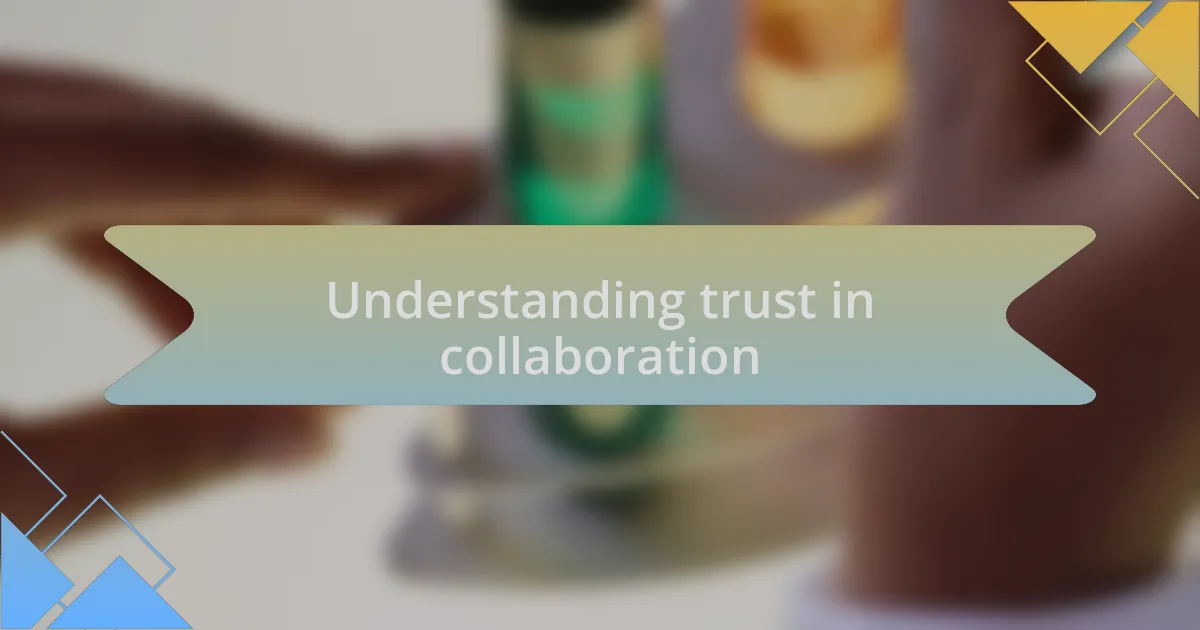
Understanding trust in collaboration
Trust isn’t just a nice-to-have in collaboration; it’s the foundation that allows individuals and organizations to work together effectively. I remember a project I participated in that required input from both African and European scientists. Initially, there were hesitations, as each group had different expectations and cultural approaches. How do we bridge those differences? It was through open dialogues that we began to share our concerns and aspirations, slowly building the trust we needed.
In my experience, trust also thrives in transparency. When team members share their insights and challenges, it creates an environment where everyone feels valued. I once worked with a colleague who was candid about her struggles in data collection, and rather than seeing it as a weakness, the team rallied around her. This willingness to be vulnerable helped solidify our relationship, highlighting how trust can transform a group into a cohesive unit that faces challenges together.
Moreover, I’ve often pondered what trust really entails. Is it about keeping promises or simply knowing someone will support you when things get tough? For me, it’s a mix of both. I feel that trust requires consistent actions over time. When colleagues stand by their commitments, they reinforce the idea that collaboration is a shared journey, where each step taken builds upon the last. This mutual reliance is what can turn a project from a mere task into a meaningful partnership.
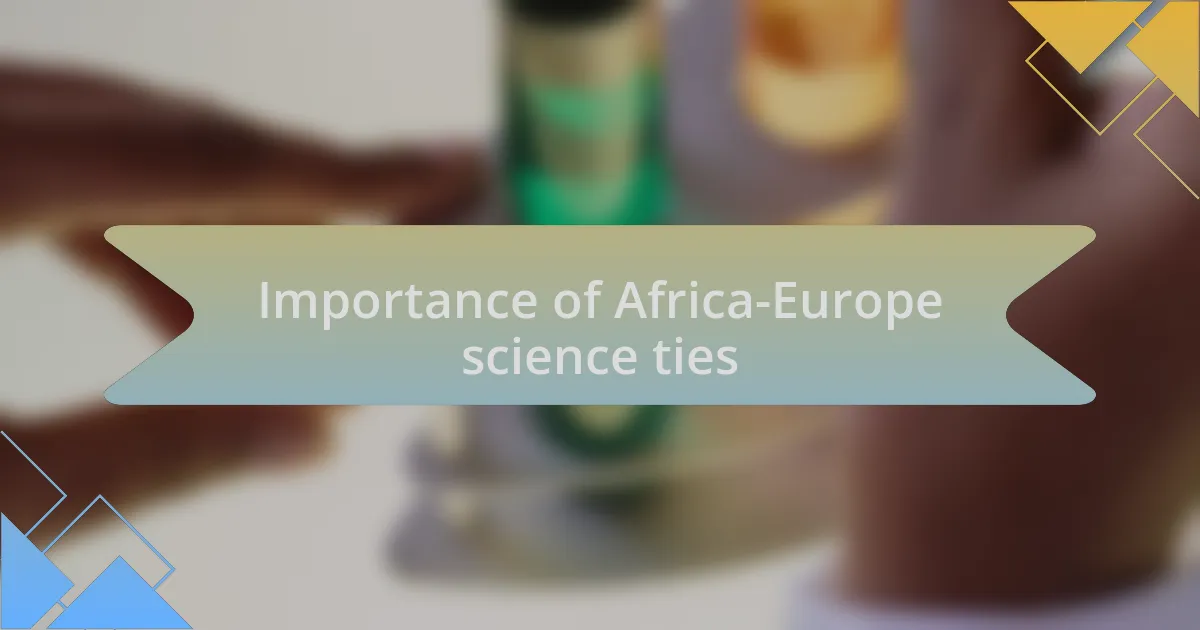
Importance of Africa-Europe science ties
The importance of Africa-Europe science ties cannot be overstated. These connections drive innovative research that addresses global challenges from climate change to public health. I remember collaborating on a project that looked at the effects of drought in East Africa. The insights from African scientists were invaluable; they brought local knowledge and context that European researchers simply couldn’t grasp.
Moreover, collaboration fosters a richer exchange of ideas, paving the way for breakthroughs that neither continent could achieve alone. In one project, we explored sustainable agricultural practices. The European side offered advanced technology, while our African counterparts shared grassroots methods honed over generations. This melding of perspectives not only enhanced our findings but also led to solutions that were practical and culturally relevant.
Ultimately, these ties cultivate a sense of shared responsibility among scientists. When I see colleagues from different backgrounds working together, I feel hopeful. The question often arises: can we really make a difference together? In my experience, the answer is a resounding yes. This mutual investment in each other’s success turns scientific endeavors into powerful catalysts for change, illustrating the importance of nurturing these international alliances.

Key principles of trust building
Building trust is fundamentally about consistency and reliability. In my experience, when working across diverse teams, I’ve noticed that delivering on promises—whether it’s meeting deadlines or sharing insights—creates a stronger foundation for collaboration. Have you ever found yourself doubting a teammate’s words? I know I have, but those moments fade when actions consistently align with intentions.
Transparency plays a crucial role as well. I vividly recall a time when I was part of a research initiative facing unexpected setbacks. Instead of hiding the challenges, we openly discussed them with all stakeholders. This honesty didn’t just ease tensions; it reinforced our collaboration. Wouldn’t you agree that knowing the full picture invites deeper engagement and trust among team members?
Lastly, fostering mutual respect is key. I cherish the times when I’ve taken moments to learn about cultural nuances and individual expertise from my colleagues. This language of respect helps break down barriers. When we show genuine interest in one another, it becomes easier to ask for help or share doubts, which ultimately strengthens our collaborative spirit. Don’t you feel more inclined to trust someone who values you as a partner?
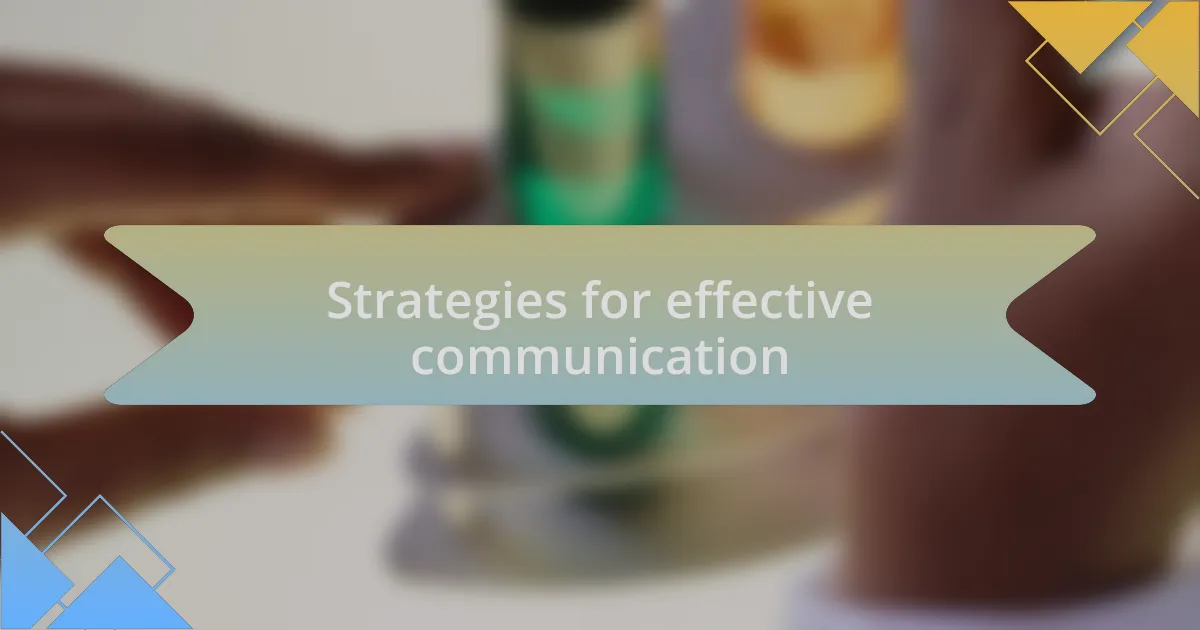
Strategies for effective communication
Effective communication is a cornerstone of building trust in any collaborative effort. I recall a time when I participated in a transcontinental project, and our first virtual meeting felt awkward due to cultural differences. To bridge that gap, we established ground rules for open dialogue and encouraged questions. This approach didn’t just make everyone feel safe to share; it transformed the dynamic into one of respect and inclusivity. Have you ever noticed how a simple shift in communication style can change the atmosphere?
Moreover, active listening is a powerful strategy that can significantly enhance communication. I remember an instance where a colleague shared a concern about project direction. Instead of brushing it off, I made it a point to listen without interrupting, reflecting back what I heard, and inviting more input. That moment not only validated their feelings but also paved the way for creative solutions we might have missed otherwise. Isn’t it remarkable how much connection can deepen through a little patience and attention?
Lastly, leveraging multiple communication channels can be highly effective. When I work with teams across Europe and Africa, I’ve found that mixing emails with instant messaging and video calls can cater to different preferences and time zones. Each format has its strengths and nuances, and understanding these allows for a more comprehensive exchange of ideas. Have you ever felt frustrated trying to convey complex ideas through one medium alone? Flexibility in communication can alleviate such frustrations and foster a more dynamic collaboration.
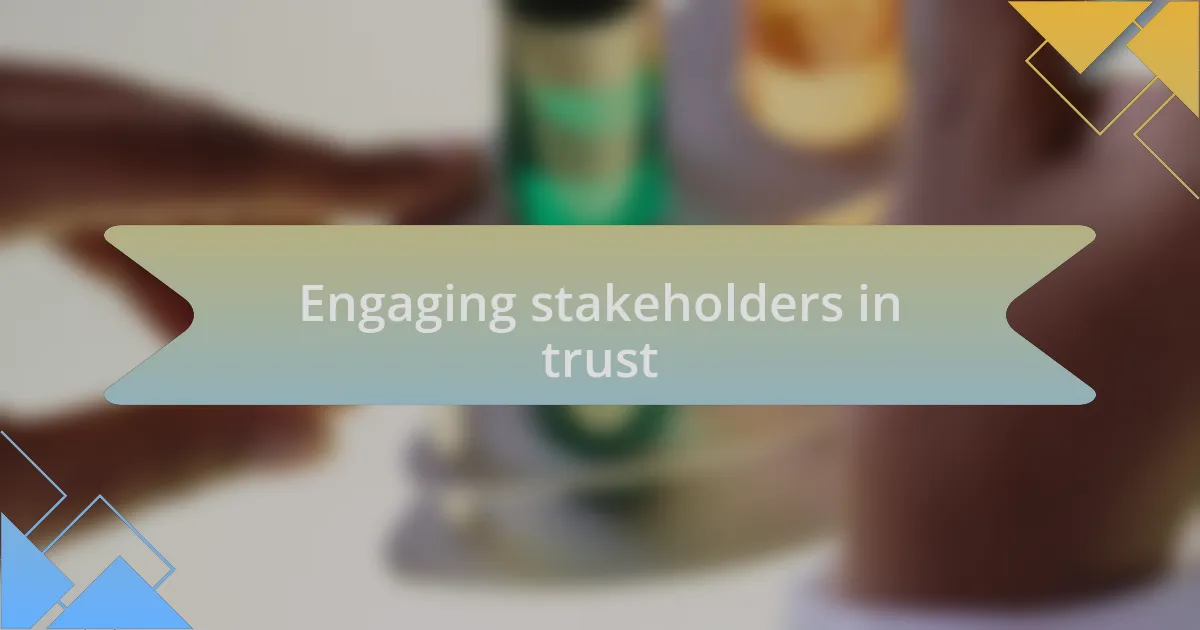
Engaging stakeholders in trust
When it comes to engaging stakeholders in trust, forming personal connections is crucial. I once attended a workshop where attendees shared their local experiences, and it struck me how stories can break down barriers. Listening to their journeys reminded me that underneath our professional roles, we all face similar challenges. Have you ever found common ground with someone that transformed your relationship? That shared experience can be an essential foundation for trust.
Building trust also means being transparent about intentions and goals. In a recent collaborative project, I made it a point to share my motivations openly during our initial discussions. Not only did this spark honest dialogue, but it also allowed others to express their hesitations. This transparency became a cornerstone for mutual trust, fostering an environment where everyone felt comfortable being candid. How often do we hesitate to lay our cards on the table, fearing potential backlash?
Lastly, involving stakeholders in decision-making can significantly enhance trust. On a project aimed at addressing community needs, I engaged local representatives throughout the planning phases. Their insights were invaluable, and the endorsement from these community figures acted as a trust multiplier. Isn’t it fascinating how giving a voice to stakeholders not only empowers them but also enriches the project? Seeing our collective effort come to fruition was a profound reminder that trust requires action and involvement.
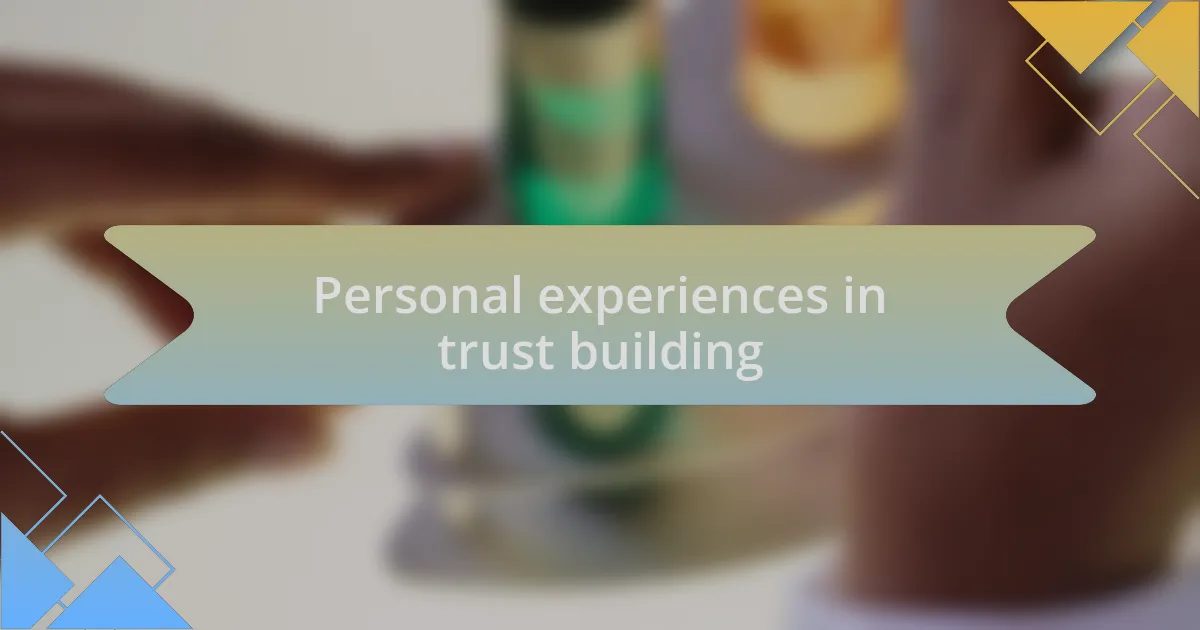
Personal experiences in trust building
One of my most significant lessons in trust building happened during a partnership meeting in Africa. I noticed a local leader hesitating to speak up, and I took a moment to acknowledge their perspective directly. After I expressed my genuine curiosity about their views, they shared their concerns, which deepened our connection. It made me realize how crucial it is to create a safe space for others, inviting them to share their thoughts without fear of judgment. Have you ever had a moment where your openness encouraged someone else to be transparent?
Another experience that shaped my understanding of trust occurred during a collaborative research project. I remember a colleague who was skeptical about our methodology. Instead of dismissing their concerns, I invited them to co-develop the approach, which turned the skepticism into shared ownership. This experience taught me that trust is often built through collaboration and respect for differing opinions. Isn’t it interesting how involving others in the process can turn apprehension into commitment?
I also recall a time when I organized a roundtable discussion with diverse stakeholders. I began by sharing a personal story about my own struggles in the field, which surprisingly opened up the dialogue. As the participants shared their own experiences, I felt a palpable shift in the atmosphere – suddenly, we were no longer just colleagues, but partners facing similar challenges. How powerful is it to connect through our vulnerabilities, reinforcing our trust in one another? That experience reminded me that authenticity can pave the way for stronger relationships.
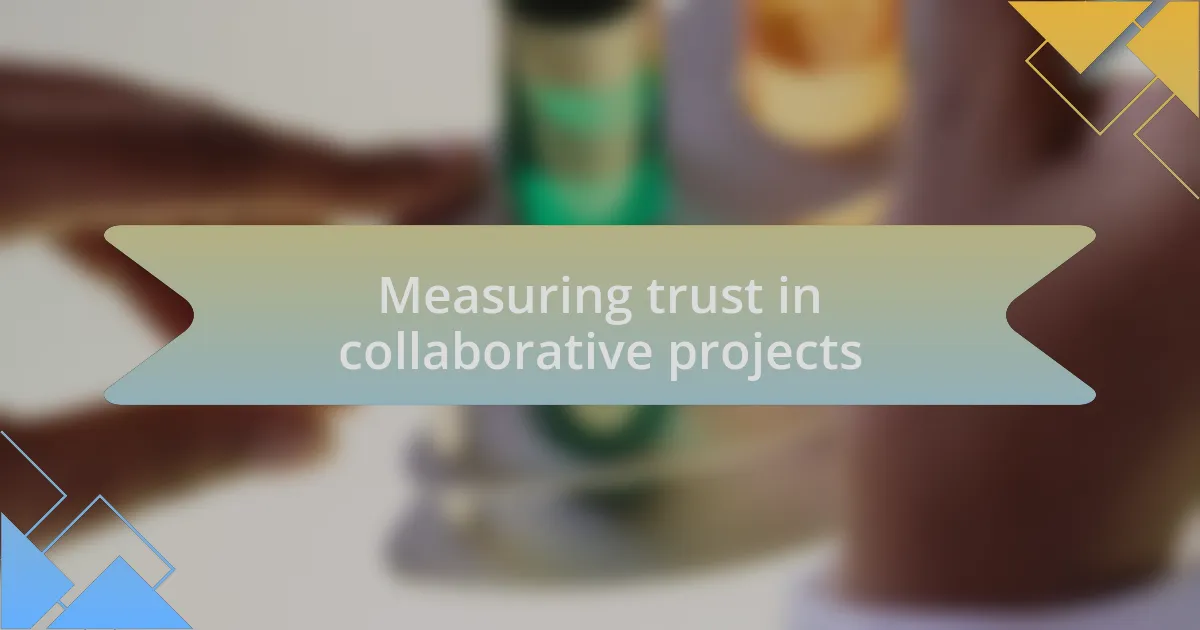
Measuring trust in collaborative projects
Measuring trust in collaborative projects can sometimes feel like trying to catch shadows. In one project, we developed a survey to gauge trust levels among partners. Surprisingly, the responses highlighted that while everyone valued collaboration, underlying skepticism was prevalent. It was a stark reminder that trust isn’t just about friendships; it’s deeply intertwined with shared goals and transparent communication. Have you ever noticed how the smallest assumptions can skew perceptions?
In another instance, we employed reflective workshops that encouraged partners to articulate their feelings regarding trust. As I facilitated the session, I was struck by how discussing trust in a structured environment led to candid revelations. Participants were hesitant at first, but gradually, they began sharing personal experiences that influenced their trust in the group. Isn’t it remarkable how a simple conversation can reveal so much about the fabric of a partnership?
Finally, I remember using a trust matrix in a project review to visualize our collective trust levels. Each partner rated various dimensions of collaboration, from communication to reliability. The visual representation sparked a rich discussion and allowed us to identify gaps and strengths. It felt empowering to confront our trust dynamics openly and collaboratively. Have you thought about how such tools could reshape the understanding of trust in your projects?